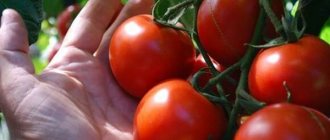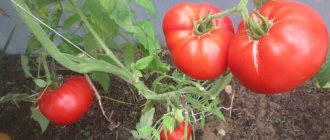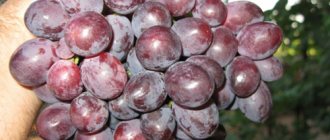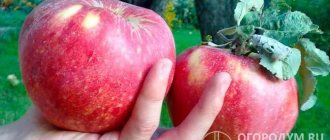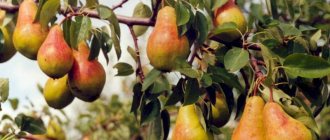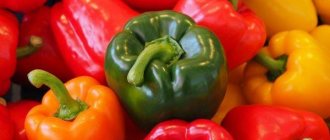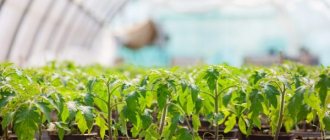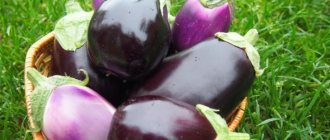Greenhouse tomatoes are popular among gardeners living in regions with difficult climatic conditions. Such areas are characterized by sudden changes in weather, heavy rains and fogs, which negatively affect the quality and quantity of the future harvest. To prevent negative consequences, Siberian and Ural gardeners plant tomatoes in greenhouses or greenhouses. Shelters protect plants and provide adequate conditions for growth and development.
Let's take a closer look at one of the best greenhouse varieties - Babushkino Lukoshko, and learn the secrets of its cultivation.
Description of the variety
The salad variety Babushkino Okoshko is a mid-early variety that ripens in 90-100 days from planting. Tomato is highly resistant to common crop diseases and insect pests.
Distinctive features
The bushes are indeterminate and are not limited in growth. The average height of the bush is about 1.8-2 m. The bushes are spreading, the foliage is dense, dark green. To obtain the best harvest, it is recommended to plant tomatoes in seedlings, having previously disinfected the seeds and prepared the soil.
Fruit characteristics and yield
Tomatoes are large, flat-round. The average weight of the fruit is about 300 g, but in some cases it reaches 700-800 g. The color is red, the surface is smooth and even. The marketability of tomatoes is excellent; Babushkino Lukoshko is often grown for sale. The taste is above average, the vegetable is excellent for making salads. Productivity is stable, from 1 sq. m summer residents collect from 10 to 12 kg of red tomatoes.
Productivity
Due to the strong difference in the weight of fruits obtained from one plant, it is difficult to accurately determine the potential yield of a variety. Each brush binds 4-6 tomatoes of different sizes, averaging 150-250 grams. It turns out that with an average indicator, you can remove 4-5 kg from a bush, and about 20 kg from 1 m2. This is a pretty good indicator for a greenhouse variety.
From tomatoes you can prepare various salads and snacks, slices, and eat them fresh. It is better to preserve it in crushed form - lecho, winter salads, dressings for soups and main courses.
How to grow seedlings
Tomato seedlings are prepared 40-50 days before planting in the garden. Some gardeners turn to the lunar calendar for help. Let's take a closer look at what is required to prepare high-quality seedling material.
Seed preparation
Before sowing, the seeds must be disinfected. The simplest and most affordable method of disinfection is heating in the sun for 5-7 days. The seeds are laid out on the veranda or loggia in direct sunlight. Solar disinfection destroys dangerous pathogens and microbes on the surface. You can also carry out the procedure using a 2-3% solution of hydrogen peroxide. The liquid is heated to a temperature of 40°C, the seeds are placed in a fabric bag and dipped in peroxide for 7-8 minutes.
To test the seeds for germination, they are germinated. To do this, disinfected seeds are placed in damp gauze and put in a warm place. It is recommended to germinate seeds in a well-ventilated room where the air temperature should be at least 23°C. Non-compliance with temperature conditions and improper storage can affect the germination level of seeds. Therefore, before purchasing, it is advised to carefully inspect the integrity of the packaging and check the expiration date.
Container and soil
Babushkino Lukoshko tomatoes are convenient to grow in plastic containers for seedlings. They are comfortable, lightweight and are sold at any gardening store. Along with the containers, pallets are purchased so that when watering, water flows out through special holes and the seedlings do not dry out.
It is convenient to place containers in pallets on a windowsill or loggia so that the sprouts receive more sunlight and heat. You can also plant seedlings in ordinary plastic cups or cardboard milk boxes. Before use, thoroughly wash the container and dry with a clean towel.
Gardeners use garden soil or ready-made compounds as soil. The advantage of the latter is that they are already disinfected in advance and equipped with nutrients. However, many people prefer to prepare the soil themselves, using peat or humus as fertilizer. For looseness, sawdust or purified river sand is added to such compositions. The soil is disinfected with a solution of potassium permanganate.
Sowing
Soil is poured into a clean container, holes 1 cm deep are made at a distance of 10-15 cm from each other. 1-2 seeds are placed in each, sprinkled with earth on top and watered with warm water. Before the first leaves appear, the container is covered with plastic wrap, which is then removed. For convenience, the seedlings are marked - the name of the variety and the date of planting are written.
Growing and care
Seedlings should receive at least 12 hours of sunlight per day. If daylight hours are short, additional lighting is provided using phytolamps or fluorescent devices. The first week, instead of traditional watering, spraying is used from a spray bottle. This is done so that the root system and foliage develop evenly. After 10-15 days, watering is organized using a pipette. It is important that the water gets directly under the root, bypassing the stems and leaves. Water only with warm water, not cold from the tap.
2 weeks after planting, tomatoes are fertilized with liquid organic matter. Chicken droppings or manure work great. The next feeding will be organized in 15-20 days. Bordeaux mixture or nettle infusion is used as a means of protection. Experienced gardeners recommend adding not only organic matter to seedlings, but also mineral complexes or growth stimulants.
What summer residents say
Gardeners who have ever grown Lukoshko leave reviews about it.
Lydia: If we talk about the description of this variety, we can say that it will appeal to lovers of large, fleshy fruits. But they grew in the greenhouse in different sizes, sometimes larger, sometimes smaller. Very sweet, ideal in vegetable salads. They are not capricious in their care.
Andrey: I planted it for two years in a row. Amazing variety. The harvest is rich from two bushes. They love fertilized soil and water. If there is not enough fertilizer, red spots may appear.
In order for these tomatoes to be large enough and have a rich taste, you need to provide them with proper care. This variety is suitable for sale and for use in home preparations.
How to grow tomatoes
The Babushkino Lukoshko tomato is recommended for growing in a greenhouse. To get a rich harvest, we will analyze in detail the secrets and recommendations of experienced summer residents.
Landing
Before planting tomatoes, carefully dig up the soil in the greenhouse and fertilize it. In addition, all debris, weeds and remains of old plants are removed from the beds. All surfaces (walls, windows) are wiped with a solution of hydrogen peroxide or Bordeaux mixture. These measures reduce the risk of future diseases and pests.
Small grooves are made in the prepared beds, the distance between them is at least 40-50 cm. Since the bush needs garter, a wooden peg is installed next to each hole. A seedling is placed in the hole, the stem is generously sprinkled with soil and watered. When transplanting seedlings, it is important not to damage the still fragile and weak stems of the plants.
Care
The key to proper care is timely watering. Every year more and more gardeners install a drip irrigation system on their plots. With the help of a convenient design, water gets directly to the root, which reduces the risk of spreading diseases. Approximately 1.5-2 liters of water are consumed per bush. The beds are watered by hand several times a season. Instead of ordinary water, use an infusion of nettle or wood ash. This method improves the taste of the fruit and protects it from pests.
Once every 2 weeks, tomatoes are sprayed with a whey solution or an infusion of onion peels. They do this to protect the bushes from Colorado potato beetles. Organic and mineral fertilizers are added to the soil three times a season. Particular attention is paid to nitrogen-containing, potassium and phosphorus preparations. Ammophos or bone meal are recognized as excellent remedies.
Features of cultivation and possible difficulties
After a month, the bushes are tied to a support. Otherwise, they may break under the weight of large and heavy fruits. The most common method of gartering is a support in the form of a wooden stick or peg. It is important not to tighten the knot tightly, as this will negatively affect the development of the bush. Next, experienced gardeners advise pinching the top to stop growth. At the same time, all side shoots are removed, as they interfere with the formation of large tomatoes.
Important! Before each watering, it is recommended to loosen the beds. Loosening improves the quality of the soil and saturates it with oxygen. Often loosening is combined with weed removal. Unwanted vegetation disrupts the microflora of the beds and slows down the growth of tomatoes.
Diseases and pests
The most common tomato disease is late blight. A dangerous fungus occurs in greenhouses due to high humidity and heat. Therefore, it is important to ventilate the structure daily using special vents. Late blight appears as brown and yellow spots on the leaves.
If measures are not taken in time, the tomatoes begin to rot and turn brown. Spraying with Oxychom or Maxim is recognized as an effective preventative against late blight. Also, sometimes root rot occurs in the beds, which occurs due to improper care and lack of vitamins. To prevent this, wood ash and watering with a solution of copper sulfate are used.
Among the pests, Colorado potato beetles and spider mites are noted. Bugs live on leaves and extract nutrients from plants. The drugs “Typhoon” or “Tornado” help get rid of them. If aphids or whiteflies have settled on tomatoes, whey-based sprays will come to the rescue.
Reviews of gardeners who planted Grandmother's Basket
Igor, Novosibirsk:
This variety pleased me with its productivity; it is perhaps the most prolific of the tomatoes that I have already grown in the greenhouse. The bush formed two shoots, and all the stepsons were removed every 12 days. As a result, the bush grew to 2.5 meters, and there were a lot of ovaries on it. The bottom tomatoes ripened first and were the largest. Other tomatoes were located almost along the entire height of the plant and their sizes were also above average, approximately 400 grams. The tomato did not get sick, and I applied fertilizer 4 times over the summer. I was also pleased with the taste of the tomato - sweet with a slight sourness and a strong aroma. I collected the seeds, and next year I will grow seedlings of this magnificent tomato myself.
Nadezhda, Rostov region:
I had three shoots, like the other indents that I grow. At the same time, I adhered to the planting pattern that was indicated on the packaging, that is, 40*60. It should also be noted that the bushes were not crowded, and the yield was pleasing. The tomatoes grew 250 grams each. I also liked the taste, not cloyingly sweet and not sour, such a real tomato taste.
Olga, Petrozavodsk:
For me it did not grow to 2 meters, but grew to about 1.6 meters. But I was amazed by its yield and the size of the tomatoes; I did not expect this from this variety. The bush was simply covered with large, beautiful tomatoes. They taste very sweet, even if they were ripened at home. The pulp is sugary and dense, and the skin seems transparent. So now this variety has been added to my list of favorites.
The nuances of growing in a greenhouse
When growing, experienced gardeners recommend following some recommendations that will help you get a rich and tasty harvest:
- use only warm water for irrigation;
- thoroughly disinfect garden tools;
- regularly ventilate the greenhouse;
- do not over-moisten the soil, this can lead to the development of diseases;
- tie up and pinch bushes in time;
- pick ripe fruits on time, without overcooking.
Video “Description of the Babushkino tomato”
This video presents the varietal characteristics of the crop.
When the first pair of true leaves is formed on the plant, the seedlings are picked. They do it as follows.
- Prepare individual containers for each bush and fill them one-third with soil.
- Carefully remove the seedling from the soil, tear off a third of the bottom of the root (to stimulate the growth of the root system), place it in a new container in the soil to a depth of the cotyledon leaves.
- Compact the soil around the crop, water it and place it on a lighted windowsill in a cool room.
Tomato transplant
Tomatoes should be planted in open ground when the crop is not threatened by return frosts. The following requirements are imposed on the future location:
- wind protection;
- nutritious soil – light, loose;
- absence of unfavorable predecessors - tomatoes do not take root well after nightshades.
Furrows are made in the ground into which the crop is transplanted. Leave a distance between the bushes sufficient to:
- it was convenient for the gardener to move around;
- the plants did not create shade for each other.
The roots are covered with pre-prepared fertile soil rich in nutrients.
Transplantation of seedlings is carried out in the absence of frost.
Subsequent care for tomatoes
We remind you that the Babushkino variety is a tall crop, and therefore you need to worry in advance about the supports to which the brushes will be tied. To prevent the bushes from bending, they are tied while still young, and the shoots are later attached.
Care will require compliance with the following rules:
- Tomatoes need constant but infrequent watering - nutritional components are absorbed only in dissolved form. The water should not be cold. Water abundantly, but in moderation, so that the beds do not “sink.”
- The earth is periodically loosened, giving more access to water and air. Get rid of weeds.
- Fertilizing is applied several times: before planting, at the time of flowering and during fruiting. Peat, manure, organic and mineral fertilizers must be added to the soil.
- Spraying is used for prevention.
- When growing in greenhouses, ventilation must be done.
- For a bountiful harvest, frequent pinching and removal of excess foliage that blocks the fruit from the sun is required.
Scheme of formation of indeterminate tomato
Harvesting and application
Tomatoes are harvested after they have acquired a firm and elastic structure. Some gardeners prefer to pick fruits at the stage of technical maturity, when the tomatoes are still light green in color. For long-term storage, tomatoes are wiped with a dry cloth and placed in a wooden box, which is covered with a clean cloth on top. An excellent place to store tomatoes is a dry cellar or basement.
Due to its attractive appearance, the Babushkino Lukoshko tomato is actively used to decorate the holiday table. The vegetable makes beautiful and tasty cuts, snacks and salads. The sweetish pulp goes harmoniously with soups and side dishes and complements the taste of meat and fish dishes. Tomatoes are used to prepare pickled preparations, pickled or canned products for the winter.
Interesting! They even make jam from tomatoes. True, this unusual delicacy is used as a sauce for meat. To add piquancy, mint or cinnamon is added to the jam.
Good afternoon. And from all your tomato varieties you can take seeds for planting
Today I ordered and paid for the seeds, but I couldn’t immediately find how to pay again and therefore some of the seeds are no longer there, but now I’ve figured it out. Thank you very much, I am a beginner gardener and with you it’s not scary. I am attaching a file with the seeds I received from you.
Valera good afternoon! I paid for the seeds. I wanted to know if it is possible to collect seeds from these fruits? Will it be a barren flower? I would like to express my gratitude to you for your website and YouTube videos; as a novice summer resident, they helped me a lot. You can purchase them from me. And also many other varieties tested by me and Valery. Fedor, how can I order seeds from you?
Valery! I received the carrot seeds on October 26th, they delivered a registered letter to my home. Thank you very much! You can choose any method - either drive up to me, or meet me in the Moscow metro, or transfer money to my Sberbank card and then I will send you an envelope with seeds by mail.
Fedor, it’s great that you can receive seeds by mail. Hello! I picked up my seeds today. I’m ashamed to admit: I have land in the Tambov region, black soil, and I never even dreamed of such a tomato harvest.
Advantages and disadvantages of the variety
The main advantage of the Babushkino Lukoshko variety is its commercial and taste qualities. The fruits have a pleasant pulp and contain many useful vitamins and microelements. Vegetables are often used to prepare dietary or children's dishes. The variety has increased immunity to diseases and pests, and is characterized by stable and high yields.
Among the disadvantages, they note the fact that tall bushes require mandatory staking and bush formation. The variety is demanding on soil composition and requires mineral and organic fertilizing.
Resistance to diseases and pests
The registration commission does not give special instructions on the variety’s resistance to diseases. This means that the tomato requires preventive treatments in closed ground, but in open ground it can show itself in unexpected ways.
The variety is very young. There are no reviews yet from vegetable growers about how resistant tomatoes are to pathogens and pests. Experienced vegetable growers are well aware that no matter what the efforts of breeders, there is not yet a single well-resistant variety. This means that the plant needs preventive treatment.
To grow a healthy harvest and not give up a single fruit to disease, you must:
- regularly treat the plantings, starting from the moment the ovary forms;
- constantly alternate fungicidal preparations, which will not allow the pathogen to become addictive;
- select varieties with previously known resistance to certain diseases or pests.
Farmer reviews
To find out what other gardeners think about the Babushkino Lukoshko variety, let’s read several reviews from popular online forums.
Irina, Ufa: “I love large-fruited tomatoes, Babushkino Lukoshko is one of the best. I have never had any problems with the vegetable; I have been growing it for the fourth year in a row. The tomatoes are aromatic and tasty.”
Maria, Penza: “I always plant the variety in a greenhouse, so the yield is much higher. The bushes are unpretentious in care and require a minimum of attention. I recommend for landing."
Pavel, Moscow: “I planted the variety for the first time. The vegetable is not bad, but it is not suitable for whole-fruit canning; large tomatoes do not fit in a jar. The care is no different from others, the taste is average.”
Official information
The variety was submitted for variety testing in 2013 by Gavrish Breeding Company LLC, Moscow, Russia. For two years, variety testing stations in all regions of the country have been working to describe all the advantages of the variety as accurately as possible and provide information to vegetable growers.
In 2015, the variety was included in the register of breeding achievements of the Russian Federation under number 8654079. The tomato was recommended by the variety testing commission for cultivation in heated greenhouses and film spring shelters in all climatic regions of the country as a salad variety and medium-early ripening period.
Video: 9 secrets of fruitful tomatoes
Greenhouse tomatoes are popular among gardeners living in regions with difficult climatic conditions. Such areas are characterized by sudden changes in weather, heavy rains and fogs, which negatively affect the quality and quantity of the future harvest. To prevent negative consequences, Siberian and Ural gardeners plant tomatoes in greenhouses or greenhouses. Shelters protect plants and provide adequate conditions for growth and development.
Let's take a closer look at one of the best greenhouse varieties - Babushkino Lukoshko, and learn the secrets of its cultivation.
More about tomatoes
Lukoshko tomatoes are usually planted as seedlings in the garden. Seedlings are germinated from seeds in the spring on a windowsill. This is a mid-season variety. It has a tall bush, the length of which can be more than two meters.
The foliage is dense and bright green. The inflorescences are simple. It is best to form the bush into one stem during growth and cut off excess foliage so that there are more fruits and they ripen faster.
The fruits are very large, sometimes reaching 800 grams with quality care. Round in shape, with protruding sides. They, like a basket, have a dent at the base. That's why they got this name. The color is red. They are meaty, sweet, sugary. Seeds are present.
This culture is immune to many diseases and resistant to any weather. The characteristics of tomatoes may indicate how to grow them correctly so that the yield is high and the taste properties are not lost.
The characteristics and description of the Grandma's Secret tomato variety are very important for understanding the benefits. It should be noted that the plant belongs to indeterminate varieties.
Bushes
- Grandmother's Secret tomatoes are powerful, but the bushes are not spreading. The height, if not limited, reaches two meters. As a rule, gardeners stop at a height of 130-150 cm.
- The tomato stems are strong, with medium foliage. The dark green leaves are large, wrinkled, and lack pubescence.
- The inflorescences are simple, formed with an interval of 2 leaves.
The first brush of a tomato is formed above the eighth leaf. The inflorescences produce 5-6, sometimes 7 fruits. Despite the power of the bush, the formation of clusters should be limited to eight, otherwise the tomatoes will be small and the ripening period will increase. - It takes 4 months from sowing the seeds of the Babushkin Secret variety to harvesting, that is, the ripening period is mid-early. The productivity of tomatoes is high; when grown in a greenhouse, one bush produces up to 8 kg of large tomatoes; in open ground, a little less.
- Tomatoes have a powerful root system, it is located near the surface and grows to the sides and produces food for the plant.
Features of the fruit
Tomatoes, according to the description of the variety and reviews of people who grow Babushkin Secret tomatoes, have a flat-round, ribbed shape. The weight of each tomato ranges from 300 to 500 grams. The diameter of the fruit is 10 centimeters or more.
There are from 3 to 6 seed chambers, but there are few seeds. Fruits with smooth, thin but dense skin. Unripe tomatoes are pale green in color, but at technical maturity they are bright crimson, as in the photo below.
Tomatoes are dense, fleshy, and have little liquid. The pulp is raspberry, sugary when cut. Tomatoes taste sweet, almost without sourness; in addition to sugar, they contain a lot of dry substances.
Tomatoes are universally used, but are not suitable for canning due to their large size. But for salads, lecho, adjika, and tomato paste, you can’t find better raw materials.
The shelf life of fruits is limited, and it can be difficult to transport them due to loss of presentation.
